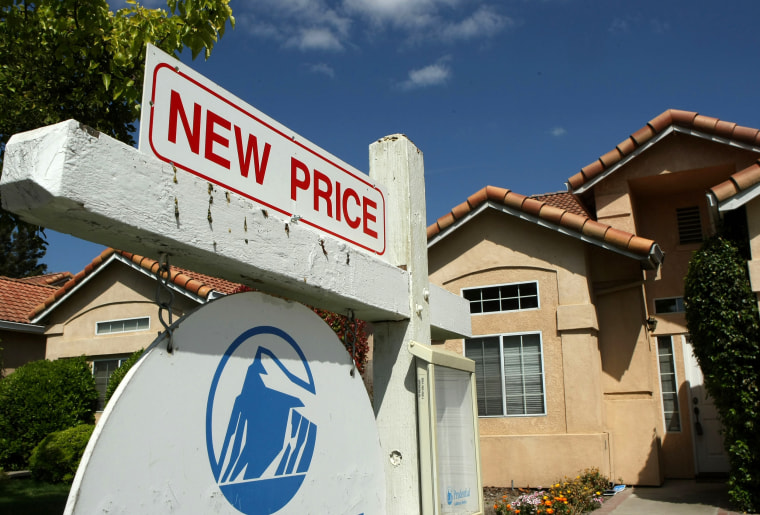After more than 10 years of saving, Joanna Flores finally had enough to make a down payment on her first home. Flores, a 35-year-old IT specialist and single mother of two in Fresno, California, said that living with her parents had enabled her to put aside a few hundred dollars whenever she could.
“There were a lot of times where I just wanted to give up,” she told NBC News. “Just knowing in the long run that I was saving up money kind of pushed me to keep on going.”
While Flores contributed to her parents' home expenses and mortgage, for the most part she focused on saving and building credit. Last year, she won a bid on a three-bedroom home for $245,000 and secured a first-time homebuyer loan. She used her $3,000 in savings and $3,000 of her pandemic stimulus to make the down payment.
"Latinos are going to be integral in driving homeownership growth for the next few decades.”
“It’s just something I wanted for my kids,” she said. “I wanted them to have a place of their own and a place they could call home.”
After losing 66 percent of their household wealth during the Great Recession, Latino homeowners like Flores are now showing record growth.
Latinos have increased their homeownership rate for six consecutive years, according to a 2020 report from the National Association of Hispanic Real Estate Professionals, a trade group. Latinos are the only demographic in the U.S. to increase their rate of homeownership, which is projected to increase from 49 percent to 51 percent from 2020 to 2040, the nonprofit public policy research organization Urban Institute reported this year. Every other racial group, including white people, is expected to decrease their homeownership rate, it found.

“Latinos have an extra proclivity for real estate as a means to build assets,” said Noerena Limón, executive vice president of public policy at the National Association of Hispanic Real Estate Professionals, or NAHREP. “Given that homeownership makes up such a big percentage of wealth, Latinos are going to be integral in driving homeownership growth for the next few decades.”
The boom in Latino homeownership is helping to drive the growth of the overall economy. The National Association of Home Builders estimates that housing makes up 15 to 18 percent of U.S. gross domestic product. In 2019, Latinos contributed $423 billion in GDP through the housing market alone, according to NAHREP. U.S. Latinos’ total GDP amounted to $2.7 trillion in 2019, which is larger than the GDP of countries such as Italy, Brazil and Canada, according to a report released Wednesday by the nonprofit data research organization Latino Donor Collaborative.
Limón said there is going to be "a seismic increase in wealth because Latinos play such a big role in driving wealth, given home price appreciation in the last year and how people build equity in their homes.”
Home prices nationwide have surged during the pandemic, with the average price now up by a record 19.7 percent in July compared to the same period last year, according to the latest data from the S&P CoreLogic Case-Shiller U.S. National Home Price NSA Index.
U.S. Latinos are much younger than other racial demographics, which means there is a larger segment of people in their prime homebuying years, said Jun Zhu, a visiting assistant professor in the finance department at Indiana University–Bloomington and a nonresident fellow with the Urban Institute. Nearly 1 in 3 Latinos is 25 to 44 years old, the age at which people traditionally buy a home, according to the U.S. Census Bureau. They also are buying homes at rates similar to past generations, Zhu said.
But at the same time, Latinos face structural challenges to buying a home, compared to their white and Asian counterparts, including less parental wealth, lower credit scores, high debt-to-income ratios and a higher proportion of self-employed workers, which slows down the rate of homeownership, Zhu said.
These barriers have only heightened over the course of the pandemic, creating the most restrictive credit access climate in six years, according to the Mortgage Bankers Association’s Mortgage Credit Availability Index. Credit access has tightened over the last two years as lenders manage an onslaught of new borrowers, prioritizing prime applicants while delinquency rates continue to be higher than pre-pandemic levels, according to NAHREP.
Latinos’ total GDP in 2019 was higher than that of countries such as Italy, Brazil or Canada.
Many Latinos are pushed out of the homebuying process early on, said Luis Paredes, a real estate agent with Century 21 Simpson & Associates in Lexington, Kentucky. Many of his Latino clients come to him ready to buy a home, but have low credit scores and high debt. Some clients without a Social Security number give up early because they don’t know they can apply for a home loan with an individual taxpayer identification number, he said.
“I tell them that just because you get turned down on a loan now doesn’t mean in a year or two, when you get credit and have enough for a down payment, you can’t try again,” he said. “As for others, they get stuck on the first part and they stop interacting with me.”
U.S. homeowners with mortgages have seen their equity increase by nearly $2.9 trillion since the second quarter of 2020, an increase of 29 percent year over year, according to a CoreLogic Homeowner Equity Insights report released this month. With Latinos making up a significant share of that equity, Latinos are well positioned to help drive the country forward, Limón said.
At the same time, Black and Latino homebuyers still face higher rates of mortgage denials and higher interest rates compared to their white and Asian counterparts, according to an analysis of home mortgage data by the Consumer Financial Protection Bureau.
“It is clear from that data that our economic recovery from the Covid-19 pandemic won’t be robust if it remains uneven for mortgage borrowers of color,” the bureau's acting director, Dave Uejio, said in a statement.
Flores said she had bid on several houses before finding her three-bedroom home in Central Fresno, and had even taken a break a few times from house hunting out of exhaustion and frustration. But now, her 16-year-old son and 8-year-old daughter each have a room of their own and a back and front yard to play in.
“This home doesn't have too much to claim, but it's just big enough to keep me busy,” she said. “I’d tell homebuyers just to have a lot of patience and don't give up — just keep going and keep trying.”
